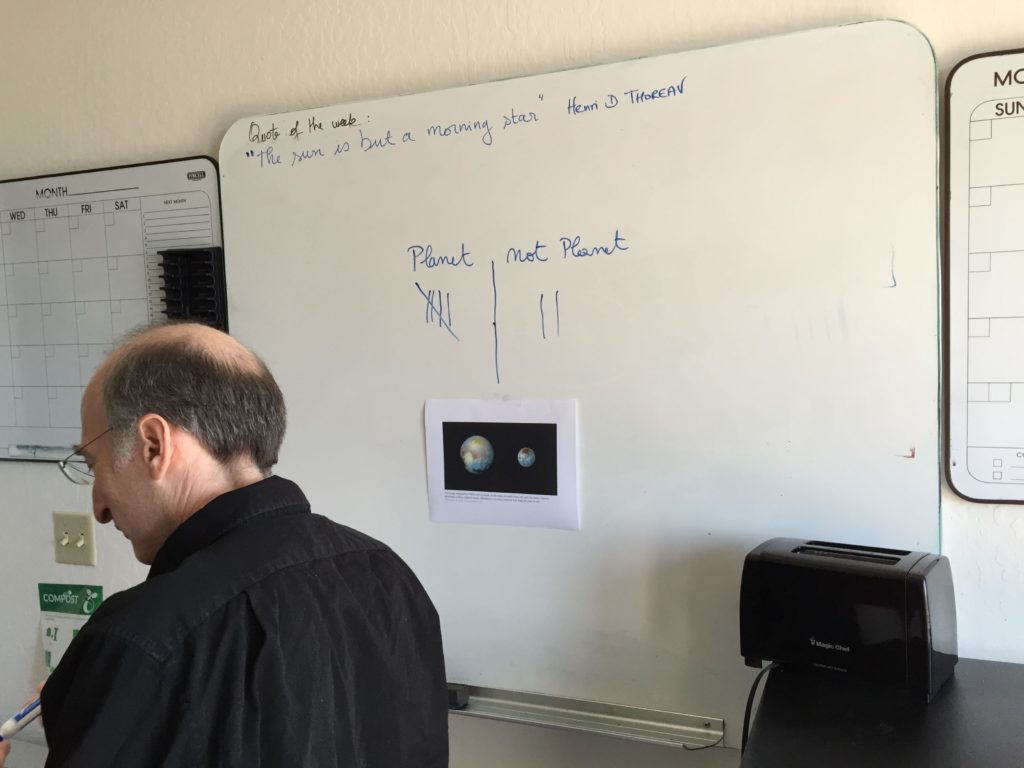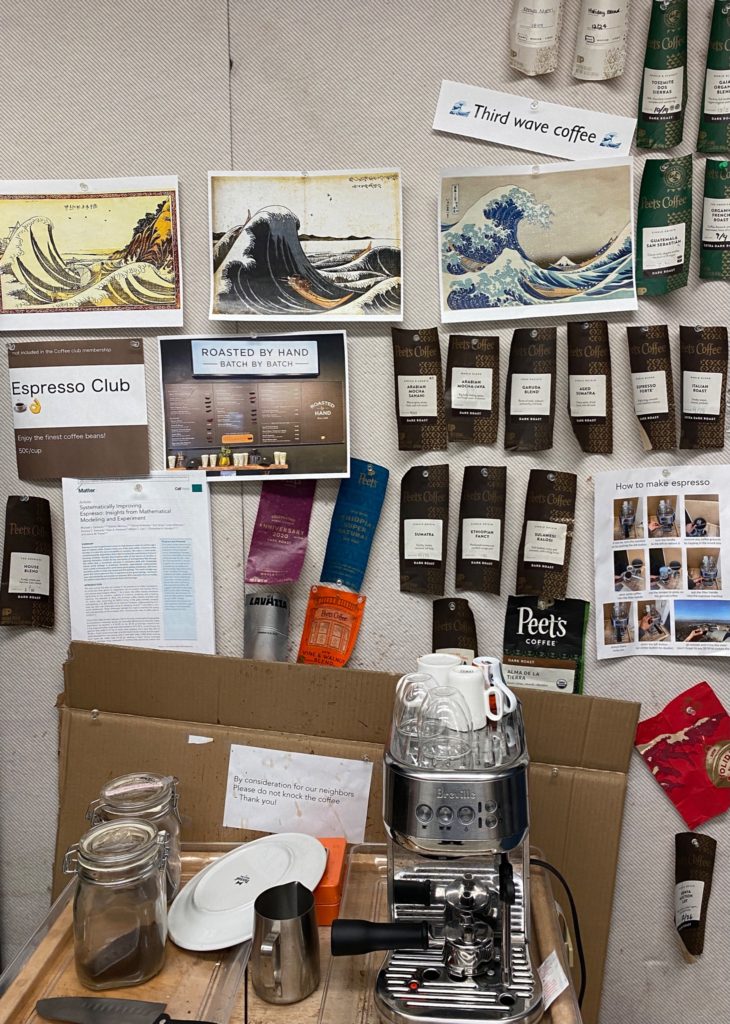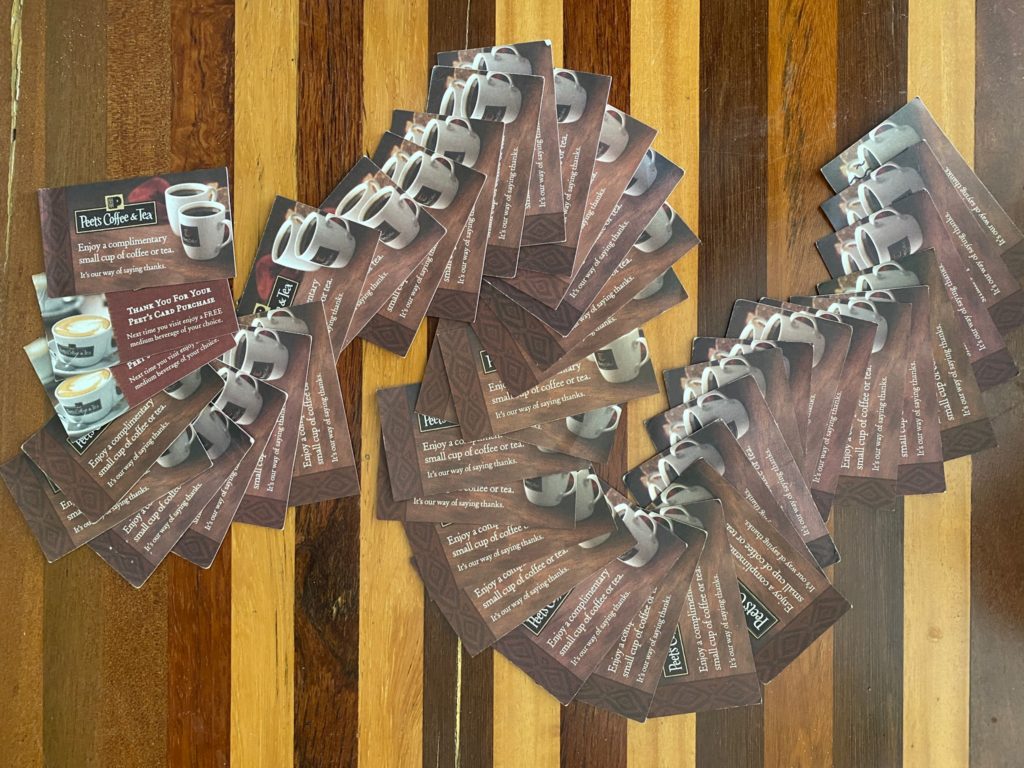The past nine months have been spent working from home, and it has now become clear that what I miss the most is the casual interactions with colleagues in the coffee room.
It is a place where ideas sparks, and where information flows from one scientist to the other. The importance of this liminal space should not be understated. It provides a safe space where ideas can be freely challenged and developed, owing to the generally low number of participants, the low stakes and the general mood.Over the years, I’ve developed several coffee clubs in my buildings (I’ve changed buildings three times), adding an espresso machine wherever I could (often on my own funds, though coffee beans where purchased collectively.)
Elementary Table of Coffee (Berkeley Lab building 2 coffee room, 2013-2016) (@awojdyla, Feb 4 2018)
The importance of the mood component became apparent as we switched to online meetings and we started to lack this kind of space (thankfully my colleague Diane B. organized regular coffee zooms!), though nothing replaces the in-person interaction, with a white board where people can share their thoughts.

Saul Perlmutter casting a definitive vote on the planet-ness of Pluto in our coffee room (Berkeley Lab building 2)
Back in the days I documented the impact of coffee in this blog piece: Experimenting espresso coffee on American scientists, providing economics details and coffee rating (for convenience, I almost always buy my coffee at Peet’s coffee, which is a Berkeley business – much better than Starbucks or Phil’z, and their roast tend to be pretty dark, ideal for espresso.) Since, we had a few upgrades. Our espresso machine went from a modest Bialetti Caffe Concerto (good but flaky) to a Rancilio Silvia (completely over-rated) to now a Breville Bambino (pretty nice.) We also upgraded with a coffee grinder, but the noise it produces is not enjoyed by everyone.

Third Wave coffee (Berkeley Lab building 2 coffee room, 2019–) (@awojdyla, Dec 22 2020)
We have also learned how to make the best coffee – there is a surprising variability here, depending on the day, whether coffee has been brewed already, the origin of the coffee and the grind. We now get a consistent crema, but there are still many tries and many errors to make. Thankfully, colleagues from other places have studied the question in further details (doi.org/10.1016/j.matt.2019.12.019)

Systematically Improving Espresso: Insights from Mathematical Modeling and Experiment (Cameron et al, 2019) doi.org/10.1016/j.matt.2019.12.019
Based on the number Peet’s card I have left (they used to hand me them as rain check, before they switched to the Peet’s app – I now get any drink for free from time to time, though I still swear by espresso only), I estimate that I have bought about 150 lbs of coffee from Peet’s, or roughly my body weight (the calculation checks out – I am all made of coffee.)

Unused Peet’s card (@awojdyla, December 27, 2020)
When there is no office to share coffee, I find myself going to coffee store. We do have a wide and good selection here in Berkeley (Artis, Highwire, bluebottle, etc.), yet my favorite espresso is from Brewed Awakening, on Euclid (they use Mr Espresso beans, from Oakland) – so good that my Italian visitors make laudatory remarks on their own (for real.) I’ve been to Seattle lately, and they do have a pretty impressive offering in terms of coffee shops (I really enjoyed Storyville), probably better than Portland (I spent too much time writing in Stumptown) or Philadelphia (great coffee scene too!)
If you still don’t believe coffee is an important part of research, here’s some statistics to back up this claim! Every lab should have an espresso machine – brewed coffee only doesn’t cut it, the ritual and the slowness is essential. Brewing coffee at home, the espresso making process is less enjoyable, and I went from French Press to Pour Over, as I cut sugar out of my coffee and the later does provide additional richness in the taste, especially with water at 85℃ and freshly ground bean – discovering the nuances of lighter roasts
Researchers drink the most coffee (from New Dunkin’ Donuts & CareerBuilder® Survey Reveals Which Professionals Need Coffee the Most, Sept 2011)